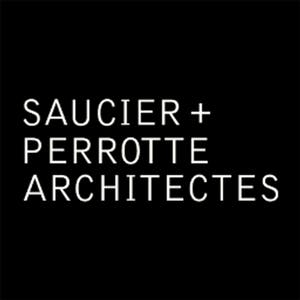
The Toronto-Dominion Centre, or TD Centre, is an office complex of six skyscrapers in the Financial District of downtown Toronto owned by Cadillac Fairview. It serves as the global headquarters for its anchor tenant, the Toronto-Dominion Bank, and provides office and retail space for many other businesses. The complex consists of six towers and a pavilion covered in bronze-tinted glass and black-painted steel. Approximately 21,000 people work in the complex, making it the largest commercial office complex in Canada.
Snøhetta is a Norwegian architectural firm headquartered in Oslo, Norway.

Toronto Metropolitan University Libraries is the library of Toronto Metropolitan University in Toronto, Canada. The library collections consist of over 500,000 books, and over CAD$3 million is spent annually to acquire electronic resources, including e-journals, e-books, databases and indexes, geospatial data, and catalogued websites or electronic documents. Most of the electronic resources can be accessed remotely by TMU community members with Internet access, although authentication of Toronto Metropolitan University Libraries registration is required for access to all commercial resources. The Libraries acquire materials to support the curriculum taught at the university and to support the research needs of faculty. All hard copy materials are housed in the Library building at Gould and Victoria Streets. In addition to library materials, the Libraries provide access to desktop computers, laptops, as well as research help and technology assistance.

Contemporary architecture is the architecture of the 21st century. No single style is dominant. Contemporary architects work in several different styles, from postmodernism, high-tech architecture and new references and interpretations of traditional architecture to highly conceptual forms and designs, resembling sculpture on an enormous scale. Some of these styles and approaches make use of very advanced technology and modern building materials, such as tube structures which allow construction of buildings that are taller, lighter and stronger than those in the 20th century, while others prioritize the use of natural and ecological materials like stone, wood and lime. One technology that is common to all forms of contemporary architecture is the use of new techniques of computer-aided design, which allow buildings to be designed and modeled on computers in three dimensions, and constructed with more precision and speed.

B+H Architects or BH Architects is a Canadian architectural and engineering firm headquartered in Toronto, Ontario. The firm was founded in 1953 by Sidney Bregman and George Hamann.
WZMH Architects is an architectural firm established in 1961 and based in Toronto, Ontario, Canada. Originally known as Webb Zerafa Menkès Housden the company's name was changed to WZMH Architects in 2002.
Zeidler Architecture Inc. is a national architecture, interior design, urban design, and master planning firm with four Canadian offices located in Toronto, Calgary, Vancouver, and Victoria.
Green building on college campuses is the purposeful construction of buildings on college campuses that decreases resource usage in both the building process and also the future use of the building. The goal is to reduce CO2 emissions, energy use, and water use, while creating an atmosphere where students can be healthy and learn.

The Shaw Centre is a convention centre located in the downtown core of Ottawa, Ontario, Canada. It opened in April 2011. The award-winning architecture was designed by Ritchard Brisbin. The Centre replaces the Ottawa Congress Centre, which opened in 1983 and is built on the site of the Ottawa Congress Centre building which was demolished in 2008–2009.

Toronto Metropolitan University is a public research university located in Toronto, Ontario, Canada. The university's core campus is situated within the Garden District, although it also operates facilities elsewhere in Toronto. The university operates seven academic divisions/faculties, the Faculty of Arts, the Faculty of Community Services, the Faculty of Engineering and Architectural Science, the Faculty of Science, The Creative School, the Lincoln Alexander School of Law, and the Ted Rogers School of Management. Many of these faculties are further organized into smaller departments and schools. The university also provides continuing education services through the G. Raymond Chang School of Continuing Education.

The Gies College of Business Instructional Facility (BIF) is a state-of-the-art business facility designed by Pelli Clarke Pelli Architects located on the Champaign campus at the University of Illinois Urbana–Champaign (UIUC).
The South Bond Building, or the former C.E. Goad Offices, is located at 105 Bond Street, Toronto, Ontario. It was built in 1912, and, starting in 1944, housed the Doubleday Canada publishing headquarters and was purchased by Ryerson University in 2006. After undergoing extensive renovations that kept the original facade, Ryerson opened the South Bond Building in the fall of 2007. In 2009, it was the first university in Ontario to be awarded a LEED Gold rating for energy efficiency.

The Image Centre is an photography and art museum in Toronto, Ontario, Canada. The centre is a university museum operated by Toronto Metropolitan University (TMU), and is housed in a renovated and remodelled former warehouse building at Gould and Bond Streets on TMU's campus. The centre includes gallery, collections, teaching, research and exhibition spaces and shares the building with the School of Image Arts.

The University of Toronto Mississauga is a satellite campus of the University of Toronto. It is in Mississauga, Ontario, Canada about 33 kilometres west of the main St. George campus. It was formerly called the Erindale College but was later changed to the University of Toronto Mississauga (UTM). The campus has eight main educational buildings: the Maanjiwe nendamowinan Building, Deerfield Hall, the William G. Davis Building, the Kaneff Centre and Blackwood Gallery, the Recreation, Athletic, and Wellness Centre, the Hazel McCallion Academic Learning Centre which holds UTM's library, the Instructional Building, and the new Terrence Donnelly Health Sciences Complex for the Mississauga Academy of Medicine. The campus also houses 3 residence halls: Erindale Hall, Roy Ivor Hall, and Oscar Peterson Hall.

The James B. Hunt Jr. Library is the second main library of North Carolina State University (NCSU) and is located on the university's Centennial Campus. The $115 million facility opened in January 2013 and is best known for its architecture and technological integration, including a large robotic book storage and retrieval system which houses most of the university's engineering, textiles, and hard sciences collections. The library is named after James Baxter "Jim" Hunt Jr., the four-term 69th and 71st governor of North Carolina. NCSU Libraries is part of the Triangle Research Libraries Network (TRLN), which shares books between North Carolina State University, Duke University, The University of North Carolina at Chapel Hill, and North Carolina Central University.

Craig Edward Dykers is an American architect and founding partner of the architecture firm, Snøhetta.

The Calgary Central Library, also known as the Calgary New Central Library (NCL), is a public library in Calgary, Alberta, Canada, and the flagship branch of the Calgary Public Library system. The building is located in the Downtown East Village neighborhood and opened on November 1, 2018, replacing an earlier central branch built in the 1960s in Downtown Calgary.
Stephen Teeple, OAA, RAIC, RCA is a Canadian architect based in Toronto, Ontario. According to critic Ian Chodikoff, "He is known for his skill in producing work that is typified by strong linearity and expressive compositions containing a rich and highly detailed palette of materials such as brick, stone and wood". In 1989, Teeple founded the architecture firm Teeple Architects. Teeple's expertise encompasses residential, commercial, institutional, cultural and civic projects including community buildings such as recreational centers, museums and libraries.

Saucier + Perrotte Architectes is an architectural firm based in Montreal, Quebec. The firm was founded in 1988 by architects Gilles Saucier and André Perrotte, and is known for designing institutional, cultural and residential projects.
Gow Hastings Architects is a Canadian architectural firm specializing in post-secondary, commercial, and public buildings. Founded in 2002 by Valerie Gow and Philip Hastings, the Toronto-based firm has designed over 350 teaching and learning spaces for institutions across Ontario.




















